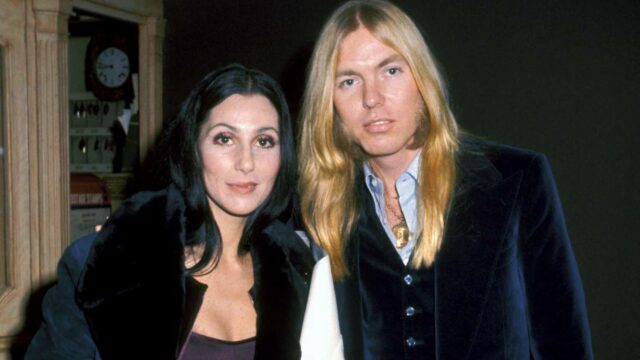Sex & Sex-Talk in the 1970s

Cosmopolitan was not the only magazine whose covers caught my attention as a child. There were also celebrity gossip magazines dishing all the latest on Liz and Dick (Elizabeth Taylor and Richard Burton). Another celebrity couple I particularly remember from childhood is Gregg Allman and Cher, then recently divorced from Sonny Bono (this will have been in 1975 when I was eleven). Pictures of Cher and Gregg out in public together were considered a big scoop, and clearly fascinated many people, although I did not understand why. Now I do.
Celebrity worship is widely mocked and deplored, but usually without noting one of its more obvious features: it is almost entirely a female phenomenon. It was not really “people” who were fascinated with Liz and Dick or Cher and Gregg, it was women. Many seemed to take a greater interest in these celebrity couplings than in their own marriages.
The explanation is that the wealth and fame of the persons involved correspond to aspects of female sexual desire largely absent from its male counterpart. Men may find a beautiful actress or model attractive, but her wealth and fame do not help constitute that attractiveness; they are a mere effect of it. For women, it is different. Liz and Dick are interesting and attractive not merely because they happen to be good-looking, but precisely because they are rich and famous. The female celebrity worshipper thinks, “What do I and my stupid, mediocre husband matter in comparison with these glamorous people I can only worship from afar?” For women, the best romance and sex can only take place at the top of the hierarchy of wealth, fame, and status. Their own love lives are dull and uninteresting by comparison. Celebrity gossip, in short, is a kind of sexual fantasy for women, a partial equivalent of what pornography is for men—although it does not carry the same opprobrium.
Apart from this illusion created by the female sex instinct, of course, Liz and Dick are not really all that special, just a rather ordinary man and woman who happen to have become rich and famous working in the entertainment industry. But women’s sexuality prevents them from seeing what was obvious to this author as an eleven-year-old boy.
Celebrity gossip is not the only female counterpart of pornography. An even clearer example is “romance fiction,” pioneered by Harlequin Enterprises. In the 1970s, these cheap, escapist novels were often called simply “Harlequin Romances” after their principal publisher. As Warren Farrell noted in 1986:
Harlequin Enterprises is an old company, but until the early seventies it was only moderately successful. In 1970, the net earnings from sales of Harlequin Romances were $110,000. By 1980, they were over $21 million. An increase of 20,000 percent.
Romance fiction continued to be a growth industry for many years thereafter, with various subgenres developing and Harlequin facing increased competition. Among women as among men, the explosion in sex-talk in the 1970s was accompanied by a turning away from actual sexual relationships and a retreat into fantasy. Of course, this means that the quantity of actual sex on offer to men began decreasing during this decade, directly contrary to what was popularly supposed at the time. And the distinction between married and unmarried sex is completely immaterial here. Men cannot marry women who are retreating into fantasy instead—any more than they can fornicate with them.
Self-help and advice books on relationships were big in the 1970s, as they still are today. They, too, were aimed almost exclusively at women. This is ironic, since women generally understand men better than men understand women. Men have far greater need of advice on dealing with women than the other way around. But there was no real market for “relationship advice books” aimed at men in the 1970s; the dumb, horny sex preferred looking at girly magazines that taught them nothing practical about dealing with flesh-and-blood women.
One “relationship” book whose title I remember spotting in a bookstore when I was young was How to Catch a Man, How to Keep a Man, How to Get Rid of a Man. Until I searched for it on the internet recently, I had forgotten that the author was Zsa Zsa Gabor: she of the nine husbands, she who boasted of being the world’s greatest housekeeper, since she had divorced seven different men and kept the house every time, the possible GOAT—or “greatest of all time”—at the sport of rotating polyandry.
The title of Miss Gabor’s learned tome certainly gives one a clear conception of how she viewed men. Ideally, a woman should be able to “catch” the man who suits her fancy, “keep” him for just as long as he continues to suit her fancy, and “get rid” of him the moment he ceases to do so—presumably to free herself to “catch” a new one she likes better!
There are, of course, men who view women in precisely the same way, as existing simply for their pleasure. Many are what is known as “psychopaths,” and they tend not to enjoy a lot of respect from more serious-minded men. Indeed, many men sternly denounce cads and playboys in the strongest terms. “A woman is not a plaything,” they will earnestly observe, “but a human being, and any man who is not prepared to treat her as such would be better advised to keep away from women.” Thank heaven women never demonstrate such an attitude toward men!
Oh, wait. That is exactly the attitude expressed in the title of Miss Zsa Zsa’s advice book, isn’t it? Was this famous Hungarian starlet ever tested for psychopathy?
Perhaps I am taking the whole thing too seriously. I see her title was classed in the “humor” category, and the chances Miss Gabor ever set pen to paper to produce the book to which she lent her name (no doubt for a handsome consideration) are almost nil. Still, the point stands that some women do regard men in a way exactly mirroring the attitude of the worst male cads. Such a woman might well think nothing of divorcing seven men in succession—and fighting to keep the house and everything else she could each time.
Another relationship title for women that I remember from my youth is Men Are Just Desserts. I see now that it was published in 1983, so it falls outside the strict chronological limits of this essay. But it still typifies a new female attitude toward men that became common in the 1970s. I never read the book, of course, but can make an educated guess as to its contents. The 1970s were the verdant spring of feminism, when women were first being urged to enter the workforce. Their lives were no longer going to revolve around their husbands and families, as in the dark days of the past. They would have exciting, high-paying careers of their own, involving no dependence upon often unreliable husbands.
But, of course, most women were still heterosexual. They still wanted a “relationship” with a man, so they would have one, naturally, but it would no longer be their bread and butter. It would only be dessert. Relationships would be carried on for pleasure, and no longer form the principal story of women’s lives. The book Men Are Just Desserts from 1983 was a slightly belated expression of the new thinking that had become common during the previous decade. (Women’s actual move into the American workplace was most rapid during the period 1983-93 in any case; the 1970s witnessed lots of talk about careers for women, but reality changed far more slowly. cf. Allan C. Carlson’s Third Ways, page 48 for details.)
My thought on seeing this title was, “What is going to happen once men realize women view them as nothing more than ‘desserts?’ Will men continue to view women the same way, treating them with undiminished consideration? Would I myself want to marry any woman who viewed me as a mere sideshow in the story of her own life?” How different all this is from the 1950s, when there could be virtually no excuse for a girl not keeping a date with a high school classmate!
Male traditionalists who think the sexual revolution was some sort of unequivocal gain for men and loss for women are thus profoundly deluded. Men have declined precipitously in the respect we enjoy from women over the subsequent decades, as books like Men Are Just Desserts and Zsa Zsa’s scholarly study serve to indicate. In many female minds, we have been reduced to a kind of combination dildo, sperm donor, and automatic teller machine. Such is the seemingly paradoxical result of a shift from a monogamous society of male-headed families to a polygynous one where women are left free to do as they please sexually. But anthropological observation backs this up. Primitive societies are generally polygamous, with as many as sixty percent of men unable to pass on their genes, yet the women in such societies tend to respect and admire men less than women in strictly monogamous societies.
https://counter-currents.com/2025/04/sex-and-sex-talk-in-the-1970s-3
